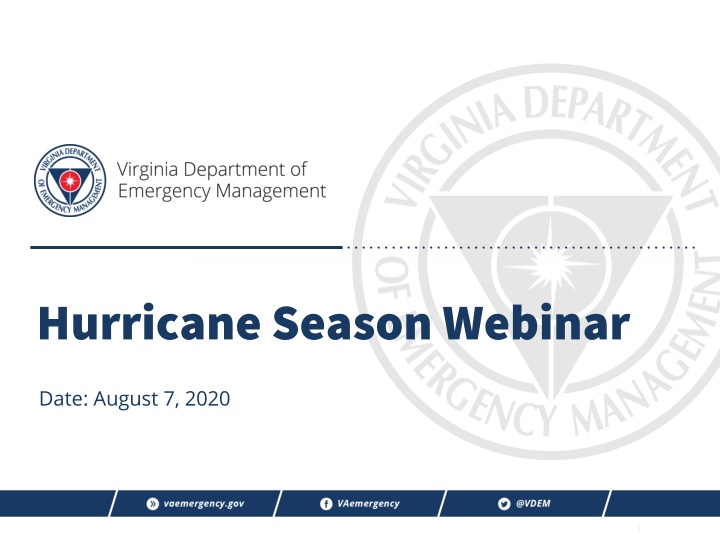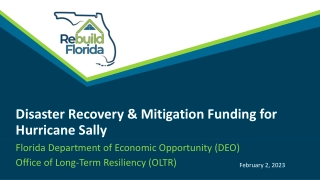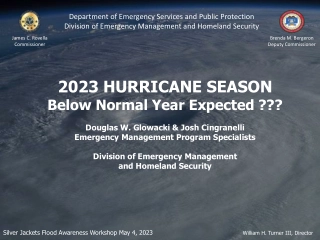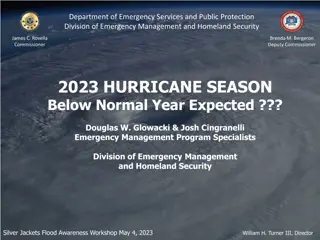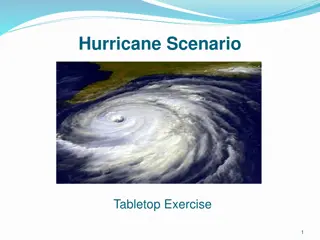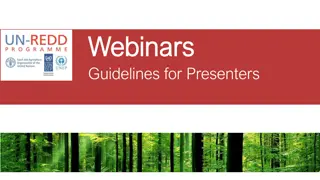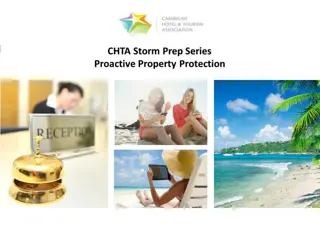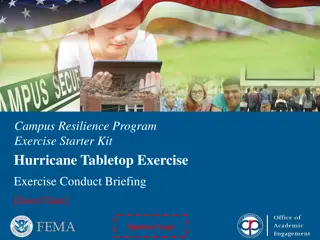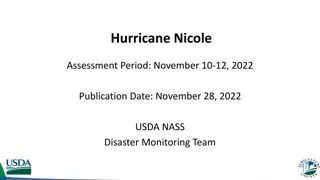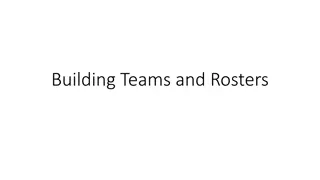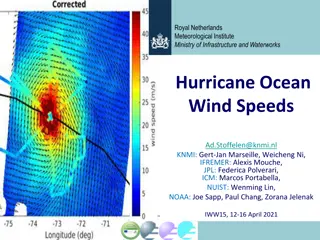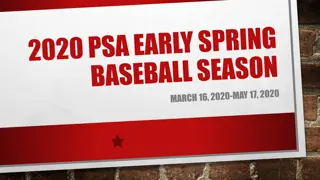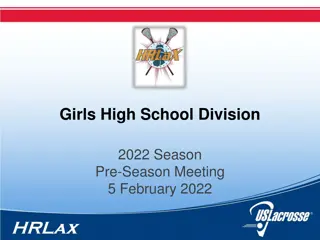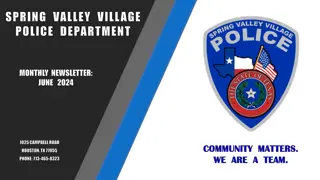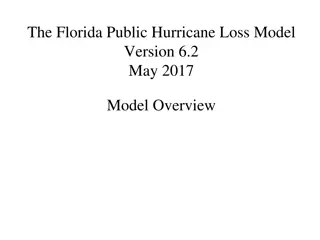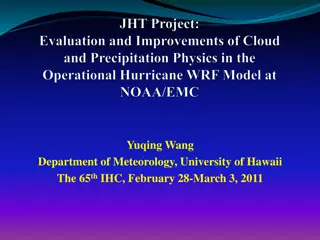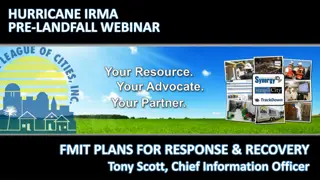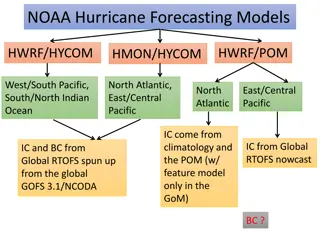Hurricane Season Webinar
State Coordinator of Emergency Management Curtis Brown appointed by Gov. Ralph Northam for VDEM. 2020 Atlantic Hurricane Season Outlook with probabilities. VDEM organizational updates and structure under COVID-19. Operational awareness and tips for localities provided by VDEM to prepare for potential disasters.
Download Presentation

Please find below an Image/Link to download the presentation.
The content on the website is provided AS IS for your information and personal use only. It may not be sold, licensed, or shared on other websites without obtaining consent from the author.If you encounter any issues during the download, it is possible that the publisher has removed the file from their server.
You are allowed to download the files provided on this website for personal or commercial use, subject to the condition that they are used lawfully. All files are the property of their respective owners.
The content on the website is provided AS IS for your information and personal use only. It may not be sold, licensed, or shared on other websites without obtaining consent from the author.
E N D
Presentation Transcript
Hurricane Season Webinar Date: August 7, 2020 1
State Coordinator of Emergency Management Curtis Brown Gov. Ralph Northam appointed Curtis Brown as State Coordinator of Emergency Management at VDEM on June 9, 2020 Curtis previously served as Chief Deputy State Coordinator and Deputy Secretary of Public Safety & Homeland Security 2
2020 Atlantic Hurricane Season Outlook Season Probability Named Storms 13-19 ---------------- Hurricanes 6-10 ---------------- Major Hurricanes 3-6 10% 30% 60% Above-normal Near-normal Below-normal Information provided by the National Weather Service 3
VDEM Structure & Updates Absorbed ISP Division from VITA (now called 9-1-1 and Geospatial Services NGS) Reorganization created four new bureaus as of July 1 NGS, Financial Management, Chief of VEST, Chief of Staff (see next slide for org chart) Currently operating virtually due to COVID-19 Currently activated for several concurrent emergency declarations o COVID-19, First Amendment Events, now in recovery phase for TS Isaias 4
VDEM Disaster Services -John Northon, VDEM Consists of Planning, Response Programs, Regional Support East, and Regional Support West Search and Rescue Hazardous Materials Provide support to local partners 6
Operational Awareness and Tips -John Northon, VDEM Localities using WebEOC to place resources and supply request prior to event Having staff trained and using Crisis Track software Know your neighboring jurisdictions resources and have MOU s in place Understand your local evacuation clearance times to allow adequate time for residents to evacuate Inland regions need to be aware of inland flooding with tropical systems 8
Planning Assumptions John Northon, VDEM Personnel limitations are likely Resource limitations likely (in-state mutual aid & EMAC) Health protection measures add complexity and cost Economic impact of COVID-19 will increase dependence on government services Traditional sheltering strategies not preferred Coordination with public health is essential at every level of response Partnership with local businesses may help fill gap Many aspects of response and recovery will be virtual 9
Sheltering Considerations in the COVID Environment Michelle Pope, VDSS State Health Commissioner issued Order of Public Health Emergency Directs non-congregate sheltering of populations temporarily displaced due to evacuation orders Where non-congregate sheltering is not possible, congregate emergency shelters may operate and shall adhere to social distancing recommendations, enhanced sanitizing practices on common surfaces, and other appropriate guidance 10
Sheltering Considerations in the COVID Environment Michelle Pope, VDSS The CDC has indicated that the highly infectious nature of COVID- 19 coupled with the potential for pre-symptomatic transmission underscores the importance of social distancing, including the avoidance of congregate settings, to reduce COVID-19 spread. The use of non-congregate evacuation sheltering is preferred because it, unlike congregate evacuation sheltering, sufficiently separates individuals from both the imminent hazard and the COVID-19 virus. Due to COVID-19, FEMA has pre-approved reimbursement for non-congregate sheltering for populations seeking emergency shelter in the Commonwealth of Virginia under Public Assistance (PA) Category B Emergency Protective Measures. 11
Sheltering Considerations in the COVID Environment Michelle Pope, VDSS VDSS, DGS, and VDEM are actively working to establish contracts to support non-congregate sheltering during the 2020 hurricane season. We recognize that in the event of a catastrophic event, congregate sheltering may be necessary. Shelter capacity (space) and capability (staff, services, supplies) for such a large-scale or catastrophic event in the Commonwealth is an ongoing concern. As such, VDSS is working to adapt the existing State Coordinated Regional Shelter Plan and its supporting procedures to ensure they meet federal and state health guidance and restrictions such as physical distancing and the use of personal protective equipment. VDSS is actively coordinating with VDEM and VDH to ensure state coordinated regional shelter planning will meet the needs of the Commonwealth and minimize the impacts that COVID-19 might have on sheltering operations 12
Virginia Emergency Support Team Michelle Oblinsky, VDEM Central organization that coordinates disaster collaboration for the Commonwealth Led by VDEM personnel Comprised of over 40 state agencies and 250 people Commonwealth of Virginia Incident Management Team Voluntary Agency Liaison Training for state agencies EO 41 involvement of all state agencies and employees in disaster response Private sector engagement 13
Diversity, Equity, and Inclusion Efforts Dr. Lauren Powell, HEWG Working Groups - -Health Equity Task Force -Health Equity Working Group - -Access and Functional Needs Working Group - -Overarching Communications Working Group Targeted DEI social media/TV/radio messaging DEI review of 2020 Hurricane Guide in the COVID-19 environment 14
Public Communications Efforts Lauren Opett, VDEM ASL interpreter for all press conferences ASL translation of all Executive Orders Translation of Executive Orders and guidance into top 6 languages - Spanish, Korean, Mandarin, Arabic, Vietnamese, Tagalog Live Spanish translation of Governor's press conferences hosted on VDEM Facebook page Accessibility review of state digital properties supporting COVID-19 response 15
Public Communications Efforts Lauren Opett, VDEM PIO meetings before, during, and after disasters - Sharing of graphics, example here: https://www.vaemergency.gov/hurricanes/storm-season- graphics/ Want to develop more robust PIO list across the Commonwealth Need to build relationships early and often Partners in preparedness - Partnering with non-profit organizations to reach and support vulnerable populations - Allows residents to receive information from sources they trust in their communities 16
Know Your Zone (KYZ) and Hurricane Guide During COVID-19 Pandemic Know Your Zone is an awareness initiative that applies to roughly 1.25 million residents in 23 localities along Coastal Virginia, the region of the state most vulnerable to hurricanes and other tropical storms 17
Virginia Sales Tax Holiday August 7-9, 2020 Eligible Items: https://www.tax.virginia.gov/virginia-sales-tax-holiday Hurricane and emergency preparedness products - Portable generators - $1,000 or less per item - Gas-powered chainsaws - $350 or less per item - Chainsaw accessories - $60 or less per item - Other specified hurricane preparedness items - $60 or less per item School supplies, clothing, and footwear - Qualified school supplies - $20 or less per item - Qualified clothing and footwear - $100 or less per item Energy Star and WaterSense products - Qualifying Energy Star or WaterSense noncommercial home or personal use - $2,500 or less per item products purchased for 18
Questions? 19
THANK YOU! 20
